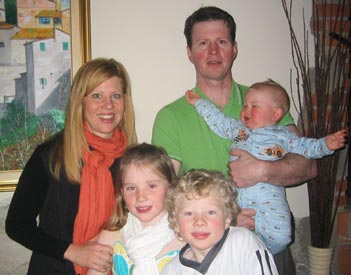Pearson-Ginsburg Chair of Thoracic Surgery Tom Waddell
 Tom with his wife Lisa and their children Alexandra, Harrison and
Nathaniel
Recently appointed to the Pearson - Ginsburg Chair
of the Thoracic Surgery Division of the Department
of Surgery Tom Waddell is keenly aware of the contributions
of those two historic thoracic surgery leaders.
Both have been his mentors. Griff Pearson launched
the careers of a large segment of the current leaders
of Academic Thoracic Surgery, among them Shaf
Keshavjee, Alec Patterson, and Joel Cooper. These and
others trained in Toronto are leaders in the specialty in
Canada, the United States, and around the world.
Describing the Division, Tom says: “Shaf Keshavjee has
put together a productive and happy team of Canadian
and International thoracic surgeons, including Mark De
Perrot from Switzerland and Kazu Yasufuku from Japan.
There is a large contingent of international fellows and
scientists within the division. These surgeons are active in
their national surgical societies, bringing greater recognition
and outreach to the division all around the world”.
Lung transplantation, the signature activity of the thoracic
division is at a peak of world pre-eminence. The
perfusion and gene therapy of damaged lungs conducted
outside the body, developed by Shaf and his colleagues
has increased the supply of these exceptionally fragile
organs for transplantation. “This technology is being
adapted by Markus Selzner for resuscitation of the liver
and it could become a great source for donor hearts.
Currently, grade 4 ventricles identified on echo prior
to harvest are discarded, though they generally have no
structural damage. They are temporarily disabled by
catecholamines released by brain injury. Similarly, hearts
from deceased donors may come back with extracorporeal
resuscitation. The work has captured the imagination
of the transplant community through Shaf ’s perseverance
and work as a spokesman, and it is now capturing
the imagination of the biotech world”.
A team system approach that has been possible in the
Thoracic Division “because it is small enough and cohesive
enough to accomplish that goal” will be more widely
adopted. For example, because referring doctors want
rapid access for their patients with thoracic disease, the
division has set up a Rapid Access Management Program
(RAMP) that facilitates referrals without reducing the
traditional patient -
|
centered approach. Doctors like
the team approach, with all of the surgeons managing
the patients and performing the procedures with equal
skill and without idiosyncratic management approaches.
“This system developed from the lung transplantation
program. We can all take over a case at any point,
knowing the rest of the team does it the same way we
do.” Bob Ginsberg started this synthesis when he fused
the Princess Margaret, Mount Sinai Thoracic Surgery
Division with the Toronto General unit. Shaf has carried
this forward into oncology and critical care as well
as transplantation.” The division is increasingly active in
critical care, using extracorporeal lung support to bridge
patients to transplantation. Our work with the Novalung
pumpless oxygenator involving cannulation of the pulmonary
artery and left atrium, using the hypertrophied
right ventricle as the driving pump is a great example of
a team success. Seven patients have been treated with
this unique technique in Toronto and a similar number
in Hannover.
“The thoracic division has been blessed with the resources
of a committed hospital, a well developed laboratory
program, the Toronto General Research Institute, the
Toronto General and Western Foundation and private
contributors such as the Latner family, the R. Fraser
Elliot Foundation, the Thomson family, the Menkes
family, the Kress family, the McEwen family. The success
of the research program was originally built on peer
reviewed grants and then has greatly expanded through
foundation and private contributions.” For example,
Tom, Shaf, Ming Yao all have CIHR and numerous
other peer-reviewed grants. This conveys to the philanthropic
community, the quality of the ongoing work
they support.”
In his own lab, Tom is using stem cell biology as the basis
of his research, including studying malignancies and lung
regeneration, e.g. growing lung tissues experimentally
from progenitor cells. He is working with embryonic
stem cells and induced pluripotent stem cells to generate
airways and lungs, and bone marrow cells that home to
the lung to help regenerate damaged lung tissue.
“The cancer research program including the thoracic
division is headed by pathologist Ming Tsao, and Kazu
Yasufuku plays a key role. Kazu is doing interesting
work on endobronchial diagnosis of lung cancer. He has
recruited a large contingent of fellows to his excellent
laboratory program. Ming Yao Liu works with Shaf on
lung injury and recovery. Mark de Perrot works with
respirologist John Granton on pulmonary hypertension.
Over time, our vision is that the thoracic unit will
continue to integrate and evolve in the way that the
Munk Cardiac Centre has grown into an internationally
renowned multidisciplinary cardiology, imaging and
surgery group.”
Tom’s wife Lisa continues her career as an architect,
though her projects are reduced during this period of
very active family life. 11 year old daughter Alexandra is
a skier, 8 year old son Harrison is a multi-sport athlete,
and two year old son Nathaniel keep the family busy -
two days a week of skiing, two nights of soccer, and three
nights of hockey. Tom has coached Harrison’s hockey
team this year, and missed only two of his daughter’s ski
races.
M.M.
|